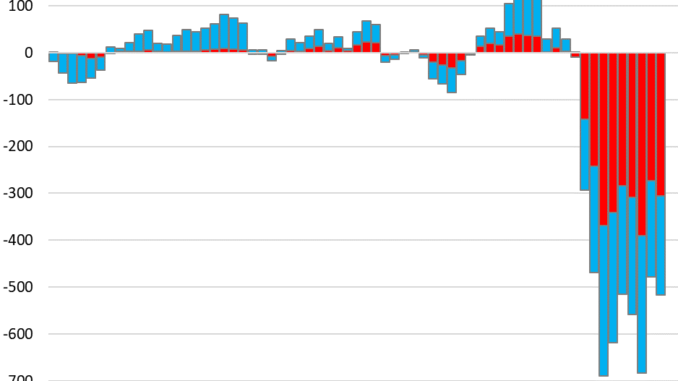
By Wolf Richter for WOLF STREET.
In Q1 2024, “unrealized losses” on securities held by commercial banks increased by $39 billion (or by 8.1%) from Q4, to a cumulative loss of $517 billion. These unrealized losses amount to 9.4% of the $5.47 trillion in securities held by those banks, according to today’s FDIC’s quarterly bank data for Q1.
The securities are mostly Treasury securities and government-guaranteed MBS that don’t produce credit losses, unlike loans where banks have been taking credit losses, particularly in commercial real estate loans. These are pristine securities whose market value dropped because interest rates rose. When these securities mature – or in the case of MBS, when pass-through principal payments are made – holders of these securities are paid face value. But until then, higher yields mean lower prices.
These unrealized losses were spread over securities accounted for under two methods:
Held to Maturity (HTM): +$31 billion in unrealized losses in Q1 from Q4, to a cumulative loss of $305 billion (red).
Available for Sale (AFS): +$8 billion in unrealized losses in Q1 from Q4, to $211 billion (blue).
HTM securities (red) are valued at amortized purchase cost, and losses in market value don’t hit income in the equity portion of the balance sheet, but are noted separately as “unrealized losses.” It’s with these HTM securities, and HTM accounting in general, where the problems reside.
AFS securities (blue) are valued at market value, and losses to due changes in market value are taken against income in the equity section of the balance sheet.
Rate-cut-mania soothed the pain, but it’s over.
Yields on longer-term securities began plunging in November and bottomed out early this year amid general Rate-Cut Mania. The plunging yields caused prices to surge, which caused the unrealized losses in Q4 to drop from the massive levels in Q3.
But in the latter part of Q1, Rate-Cut Mania began to subside, yields rose again though not back to October-levels, and so the unrealized losses in Q1 rose as well.
The $5.47 trillion in securities held by banks.
During the pandemic money-printing era, banks, flush with cash from depositors, loaded up on securities to put this cash to work, and they loaded up primarily on longer-term securities because they still had a yield visibly above zero, unlike short-term Treasury bills which were yielding zero or close to zero and sometimes below zero at the time. During that time, banks’ securities holdings soared by $2.5 trillion, or by 57%, to $6.2 trillion at the peak in Q1 2022.
That turned out to have been a colossal misjudgment of future interest rates. The misjudgment already caused four regional banks – Silicon Valley Bank, Signature Bank, First Republic, and Silvergate Bank – to implode in the spring of 2023 when spooked depositors yanked their money out.
In theory, “unrealized losses” on securities held by banks don’t matter because at maturity, banks will be paid face value, and the unrealized loss diminishes as the security nears its maturity date and goes to zero on the maturity date.
In reality, they matter a lot as we saw with the above four banks after depositors figured out what’s on their balance sheets and yanked their money out, which forced the banks to try to sell those securities, which would have forced them to take those losses, at which point there wasn’t enough capital to absorb the losses, and the banks collapsed. Unrealized losses don’t matter until they suddenly do.
The value of securities held by banks ticked up in Q1 to $5.47 trillion, after having already ticked up in Q4, but is still down by $786 billion, or by 12.6%, from the peak in Q1 (purple in the chart below).
HTM securities have declined steadily from the peak in Q4 2022, and dipped further in Q1, to $2.44 trillion, down 12.7% from the peak (red).
AFS securities rose for the second quarter in a row, to $3.02 trillion but remain 26.4% below the peak in Q1 2022 (blue).
Several factors make up the decline of securities on bank balance sheets from the peak, including:
The portion of securities of the collapsed banks that the FDIC sold to non-banks are no longer part of it.
Banks have written down AFS securities to market value.
Some securities matured.
Banks may have sold some securities.
The longer till maturity, the bigger the interest-rate risk.
Interest rate risk — the risk of falling prices as yields rise — increases with the term of the security or loan. The 30-year Treasury securities sold in the summer of 2020 have lost the most in market value, while 5-year Treasury securities sold at the same time are now just a year from maturing and are trading at small losses from face value.
To gauge this risk on bank balance sheets, the FDIC provides data on securities and loans by remaining maturity:
Least risky (green): 3-5 years: 8.2% of total assets.
Riskier (blue): 5-15 years: 13.7% of total assets, lowest since Q2 2020, after substantial declines.
Riskiest (red): 15+ years: 14.2% of total assets, lowest since Q2 2020.
Take the Survey at https://survey.energynewsbeat.com/
ENB Top News
ENB
Energy Dashboard
ENB Podcast
ENB Substack





